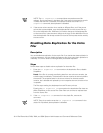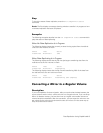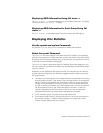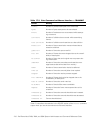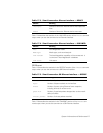
17-2 Dell PowerVault 720N, 740N, and 760N System Administrator and Command Reference Guide
Determining how much space on each disk is available to the filer. Refer to
Understanding Usable Space on Each Disk in Chapter 3 for more information
about disk capacity.
Determining the status of the disk operations, such as RAID scrubbing, recon-
struction, parity verification, adding a hot spare, and disk failure.
You can obtain the information displayed by
sysconfig -r
from SNMP, using the
Dell custom MIB. For information about SNMP, see Using SNMP in Chapter 4.
'LVSOD\LQJ7DSH'ULYH,QIRUPDWLRQ8VLQJV\VFRQILJW
The
sysconfig -t
command displays device and configuration information for
each tape drive on the system. Use this command to determine the capacity of the
tape drive and the device name before you use the
dump
and
restore
commands.
'LVSOD\LQJ2YHUDOO)LOHU,QIRUPDWLRQ8VLQJV\VFRQILJY
The
sysconfig -v
command displays the systems RAM size, NVRAM size, and
information about devices in all expansion slots. This information varies according to
the devices on the filer. You can specify a slot number to display information about a
particular slot. Slot numbers start at 0, where slot 0 is the system board.
'LVSOD\LQJ2YHUDOO)LOHU,QIRUPDWLRQ8VLQJV\VFRQILJ
If you enter
sysconfig
without any options, information similar to what you get
with
sysconfig -v
is displayed, but the information is abbreviated. When you
report a problem to Dell, provide the information displayed by
sysconfig -v
. This
information is useful for diagnosing system problems.
'LVSOD\LQJ9ROXPH,QIRUPDWLRQ
8VHWKH9ROVWDWXV&RPPDQG
The
vol status
command displays information about a volumess configuration.
The types of information displayed depend on the command options. When you spec-
ify a volume, the information for that volume is displayed; when you do not specify a
volume, the status of all volumes in the filer is displayed.
'LVSOD\LQJ9ROXPH6WDWH,QIRUPDWLRQ:LWK9RO6WDWXV
With no options, the
vol status
command displays a one-line synopsis of volume
states. This includes the volume name, whether it is on-line or off-line, and other
states, for example, partial, degraded, and so on.
'LVSOD\LQJ'LVN,QIRUPDWLRQ8VLQJ9ROVWDWXVG
The
vol status -d
command displays information about disks. The disk informa-
tion is the same as the information from the
sysconfig -d
command.



